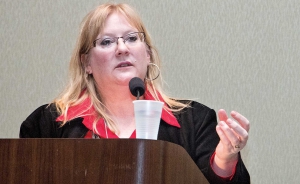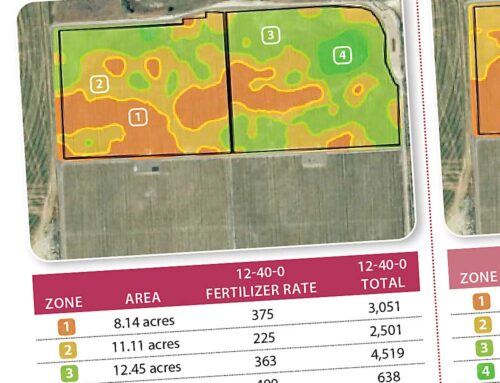
Amy Irish-Brown
Growers who use microsprinkler irrigation in their orchards may be able to use the system to gain some protection from frost and freezes.
In Michigan last year, Dr. Julianna Wilson, Michigan State University’s tree fruit integrated pest management outreach specialist, worked with two fruit growers and tree fruit educator Amy Irish-Brown to see how well that might work.
The idea is to put water on the ground and get some temperature increase as the water cools and freezes. Water releases heat as it cools and much more as it changes from liquid to ice.
Irish-Brown reported the results at the Great Lakes Fruit, Vegetable, and Farm Market Expo while Wilson was on maternity leave.
A frost event was predicted for May 12, 2013, in the Fruit Ridge of western Michigan. Prior to that, two farms were selected for monitoring: one near Comstock Park and one near Belding.
Three locations within high-density apple blocks that had microsprinklers already installed, and one location in a block without microsprinklers (control-check), were selected at each farm.
Three temperature loggers were installed at each location at three different heights within the canopy: on the lowest branch (about two feet), at chest height (about five feet), and in the upper canopy (seven to nine feet).
The two grower cooperators ran sprinklers at will and reported timing and duration after the event.
Temperatures fell to 26˚F in Mark Chase’s orchards near Comstock Park, but got no lower than 28.3°F in the blocks with microsprinklers. “The injury threshold is 28˚F,” Irish-Brown said. “That’s the break point.”
They recorded temperature increases of 2 to 5 degrees at ground level, 2 to 3 degrees at chest height, and 0 to 1 degrees higher in the trees.
Similar results occurred at Ed and Mike Wittenbach’s orchards near Belding. The temperature got colder there—falling to 23.8˚F—and temperature was raised 3 to 5 degrees at ground level, 0 to 2 degrees at chest height, and 0 to 1.5 degrees higher in the trees in the blocks with microsprinklers.
“Although this did not always raise the temperature above the injury threshold (28°F), duration of exposure to temperatures below 28°F was shortened with the use of microsprinklers,” Wilson said in an e-mail exchange with Good Fruit Grower.
“In the upper canopy, there was little to no difference between the blocks with microsprinklers versus the blocks without; temperatures dipped below the 28°F threshold at both farms regardless of treatment.”
The most important consideration for installing this kind of system is water capacity. A well or pond with 40 gallons per minute per acre capacity is required to run the system all night long for the prevention of frost injury, Wilson said.
“This study demonstrated that the upper part of the canopy will not be protected by this system, and it works best when temperatures remain within a few degrees of the 28°F injury threshold,” she said. “Because of these limitations, a system like this is probably most useful in blocks of high-density apple varieties that are of high value.”
There are two heat sources provided in this system, assuming that the water source is groundwater: the latent heat of groundwater and the heat produced when water changes to ice. Groundwater is typically 40 to 50 degrees, releasing heat as it cools to match the air temperature. When water changes to ice, it generates what is called the heat of fusion. Water gives up 80 times as much heat going from liquid to ice than it does when cooling by one degree.
Since the disastrous freezes of 2012, interest in finding ways to avoid the effects of subfreezing weather has greatly increased. The use of microsprinklers as a form of frost protection is just one of many methods that have been adopted by growers over the years. •






Leave A Comment